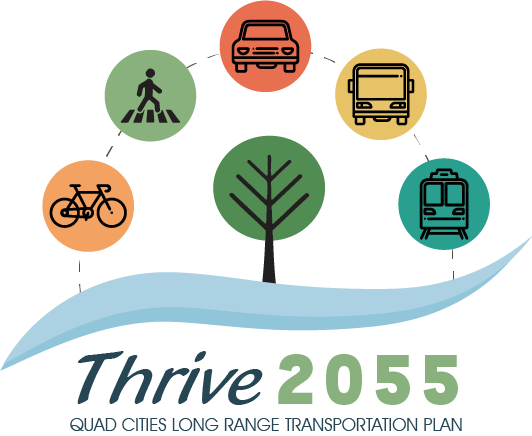- Details
- Written by: Sarah Grabowski
- Category: Transferred From Old Site
- Hits: 8899
May 28, 2014 – With the repairs and closure of the Centennial Bridge, traffic congestion is anticipated on the other inner city bridges, Government Bridge and I-74. Bridge repair includes two transverse beam replacements. Work will be from June 23 to October 1, 2014. Complete bridge closure is planned for up to 35 consecutive days (August 3 - September 5). There will be intermittent one lane, off peak-hour closures at times during prior/post bridge closure. Pedestrian and bicycle access will be available during Centennial Bridge construction.
- Details
- Written by: Sarah Grabowski
- Category: Transferred From Old Site
- Hits: 6336
May 28, 2014 – Denise Bulat, Executive Director, reviewed the status of the draft 2014 Comprehensive Economic Development Strategy (CEDS) Progress Report. She provided commissioners a draft of the Opportunities & Threats, Demographics, and Projects Planned/Underway/Completed sections of the report. Staff members continue with efforts to make the document more graphic to convey data and showcase economic development projects. Staff is also updating the look of the report by increasing the sophistication of the page design and color schemes.
- Details
- Written by: Sarah Grabowski
- Category: Transferred From Old Site
- Hits: 6064
May 28, 2014 – Denise Bulat, Executive Director, reviewed the draft FY 2015 Budget as recommended by the Finance and Personnel Committee. She reported revenues for FY 2015 are projected to be down 0.3% from the current year, primarily due to changes in contracts.
- Details
- Category: Transferred From Old Site
- Hits: 1592
Give Public Input on Future Transportation Needs and for the Greater Quad Cities Economy.
- Details
- Written by: Sarah Grabowski
- Category: Transferred From Old Site
- Hits: 6358
April 23, 2014 – Jamie Lange of Western Illinois University and WQPT explained the Quad Cities Public Broadcasting Service (PBS), Embracing Our Military initiative highlights the Quad Cities community-wide commitment to care for and support service members, veterans, Department of Defense civilians, defense contractors, and their families. The essential contributions the military and veteran population make toward the prosperity of our Quad Cities region will be recognized.
- Details
- Written by: Sarah Grabowski
- Category: Transferred From Old Site
- Hits: 5912
April 23, 2014 – Bi-State Regional Commission contracted with a consultant team, URS Corporation, ETC and Texas Transportation Institute, to conduct a household travel survey and enhance the current metro area travel demand model for predicting future traffic. Not since the late 1960s has a study of this type been done for the Quad Cities.
- Details
- Written by: Sarah Grabowski
- Category: Transferred From Old Site
- Hits: 5544
April 23, 2014 – Prior to the Bi-State Regional Commission budgeting process, staff annually prepares the Transportation Planning Work Programs (TPWP) for the Quad Cities metropolitan planning area (MPA) and Region 9, serving rural Scott County and Muscatine County. The Work Programs reflect staff work tasks/activities for the coming fiscal year related to cooperative, continuing, and comprehensive (3 “C”s) transportation planning. The TPWPs include budgets for transportation planning short and long range activities and delineate federal, state and local planning funds. Activities include staffing transportation meetings, technical assistance, such as grant writing and traffic or trail studies/analysis, as well as the development of various modal plans and transportation funding programming. As an example, $13.5 million dollars was programmed to roadway projects in the Quad Cities and Region during the current fiscal year.
- Details
- Written by: Sarah Grabowski
- Category: Transferred From Old Site
- Hits: 11134
March 26, 2014 –Current Schedule:
Final Design Complete: 2014
Iowa Right of Way (ROW) and Demolition Complete: 2014
Bettendorf/Moline Central Business District Project Construction: 2015/16
Illinois ROW and Demolition: 2010-2016
Final Construction: 2018-2021*
*(Central Bridge Section from bluff to bluff to begin no later than calendar year 2017.)
- Details
- Written by: Sarah Grabowski
- Category: Transferred From Old Site
- Hits: 8797
 March 26, 2014 – Denise Bulat, Executive Director reported the Environmental Protection Agency (EPA) is undertaking a reconsideration of the 2008 National Ambient Air Quality Standard (NAAQS) for ozone in the range of 0.070 to 0.060 parts per million (ppm). EPA’s proposed range would result in a large portion of the United States being classified as nonattainment. Lowering the 0.075 ppm standard to the lower end of the proposed range of 0.060 ppm would result in almost tripling the number of counties being designated in non-attainment in the U.S. The National Association of Counties (NACO) has determined that 96% and 76% of current monitors would fail at the 0.060 and 0.070 ppm standards, respectively (compared to 48% at the 0.075 ppm standard). All monitored areas in Iowa and Illinois would be classified as non-attainment if the 0.060 ppm standard were adopted. All but six of the 51 monitors in Iowa and Illinois would be in non-attainment at a standard of 0.065 ppm.
March 26, 2014 – Denise Bulat, Executive Director reported the Environmental Protection Agency (EPA) is undertaking a reconsideration of the 2008 National Ambient Air Quality Standard (NAAQS) for ozone in the range of 0.070 to 0.060 parts per million (ppm). EPA’s proposed range would result in a large portion of the United States being classified as nonattainment. Lowering the 0.075 ppm standard to the lower end of the proposed range of 0.060 ppm would result in almost tripling the number of counties being designated in non-attainment in the U.S. The National Association of Counties (NACO) has determined that 96% and 76% of current monitors would fail at the 0.060 and 0.070 ppm standards, respectively (compared to 48% at the 0.075 ppm standard). All monitored areas in Iowa and Illinois would be classified as non-attainment if the 0.060 ppm standard were adopted. All but six of the 51 monitors in Iowa and Illinois would be in non-attainment at a standard of 0.065 ppm.
- Details
- Written by: Sarah Grabowski
- Category: Transferred From Old Site
- Hits: 8340
March 26, 2014 – Mark D. Hunt, Project Manager, provided a brief update on the status of the 2014 Comprehensive Economic Development Strategy (CEDS) Progress Report. Mr. Hunt began by noting that over the past seven-years, EDA funding had accounted for $8.7 million in federal investment across the Bi-State Region and $17 million when local match is included. He noted that the CEDS process was a key component in making the region eligible for EDA funds. The CEDS is updated annually and fully redeveloped every five years. The strategy must be completed for the region to receive federal funds from the Economic Development Administration (EDA). The EDA has partnered in funding several projects over the past years as shown below.


